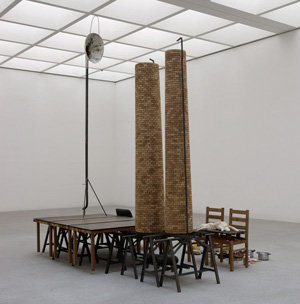The Absence of Mark Manders
dal 13/10/2007 al 24/11/2007
Segnalato da
13/10/2007
The Absence of Mark Manders
Kunstverein Hannover, Hannover
The artist has developed installative sculptural works since the late 1980s that are laid out as fragments of a self-portrait in the form of imaginary rooms. This conceptual design of the ego as architecture whose structure is preserved in various ground plan, leads to an artistic practice which comprehends sculpture as precise spatial materializations of thoughts and feelings.

Solo show
The Kunstverein Hannover presents the most wide-ranging exhibition of works by the Dutch artist Mark Manders (born 1968) to be shown in Germany until now. In conjunction with a sculptural setting developed especially for these spaces, the presentation of works made between 1990 and 2007 enables a comprehensive view of one of the most striking and original positions in contemporary sculpture. Manders attracted international attention with his exhibitions at the XXIVth Biennale in São Paulo (1998), the Venice Biennale (2001), and the Documenta (2002).
Under the title Self-Portrait as a Building, Mark Manders developed installative sculptural works since the late 1980s that are simultaneously fragments of a self-portrait and elements of an imaginary building. This conceptual design of the ego as architecture whose structure is preserved in various ground plan, leads to an artistic practice which comprehends sculpture as precise spatial materializations of thoughts and feelings. "What interests me is the moment when the difference between thinking an the objects of thought falls away, and the fact that these things direct my thoughts", says Mark Manders. The self-portrait refers in equal measure to the real Mark Manders and the fictional ego he has constructed. This simultaneous presence and absence of the ego in Mark Manders' construct of ideas creates a curious situation tilting between the works' dream-like distance and their immediate factual presence. Like surreal three-dimensional images, machine and factory-like constellations, converted furnishings, modeled or cast sculptures of humans and animals are grouped around a host of prosaic personal objects forming a world of objects which embroils the viewer in the mysterious structures of the self.
Inhabited for a Survey (First Floorplan from Self-Portrait as a Building) from 1986 shows one of the first ground plans of a mental self-portrait. The architectonically constructed body produced out of a variety of different writing utensils can be read as an internal building plan as well as a double-headed creature without arms or legs. The motionlessness of the ground plan as well as the body's corporeality is characteristic for the predominant melancholy atmosphere of Manders' works in which time seems to stand still as if frozen. The use of writing utensils – as links between object and speech – simultaneously points programmatically to the importance of speech in Manders' work which translates thoughts or terms respectively into sculptural constellations. The structure of the work is also comparable to a sentence construction in which always-new contents are formed from repeated words. In Finished Sentence (1998–2006), a kind of switch plan comprising thick wires and carefully rowed teabags at the sides is developed from the building plan of Manders' first forward-looking work. One can almost physical feel the energy flowing through the wires fed by the little poetic teabags and discharged into a kind of funnel.
The collage-like assembly of diverse objects, which are removed from their intrinsic functions and arranged in an unconventional system, is characteristic of Manders' method. The usually handmade, carefully placed objects are often connected to each other and brought into balance with string, wire, pipe, and wood. The precision of his artistic procedure can also be seen in the reduction of many of his works to 88% of their original size. With these extremely fine, just barely perceptible shifts, Manders withdraws his constellations from the norm just enough that they remain both a model of their own selves and concrete reality. This results in a simultaneous perception of the scenes as familiar and foreign.
Manders compares the creation of an imaginary space with the manufacturing of a sheet of white paper. "One creates the space to think." Drawing itself is in turn understood as an investigation of thought. The bundles of lines accurately leading from the pictorial motif to the vanishing point in the Drawing with Vanishing Point series give the impression that the drawing itself was projected from this vanishing point as an autonomous manifestation of thought that grew from the depths of the page. Similar to the architectural plan that ranslates the complexity of the ego into a level geometric structure and thereby points out the difference between the actual subject matter and the projection it fashions, the drawing also further elucidates the conceptual transformation of the ego to another. By following this logic, he bestows a form to the most personal by means of the things direct presence that simultaneously achieves general validity as a conceptual design.
Hatje Cantz will publish a catalog on the occasion of the exhibition:
Edited by Stephan Berg (Kunstverein Hannover), Philippe Van Cauteren (S.M.A.K., Ghent), Mirjam Varadinis (Kunsthaus Zurich), and Solveig Ovstebo (Bergen Kunsthall), 2007. With texts by Stephan Berg, Douglas Fogle, Mirjam Varadinis, and Mark Manders. Paperback, 20 x 27.5 cm, 280 pages, numerous color illustrations. English with addenda in German and Dutch, ISBN 978-3-7757-2031-1, 30 € / Price for members 25 €
Talking Labels Members of the Kunstverein staff answer your questions about the exhibition every Sunday from 4 to 5 p.m. and every Wednesday from 5 to 7 p.m.
The exhibition has been generously supported by:
Mondriaan Stichting
Stiftung der Sparkasse Hannover
Land Niedersachsen
The Cultural Office of the State Capital Hannover institutionally supports the Kunstverein.
The exhibition The Absence of Mark Manders was organized jointly with the S.M.A.K. Ghent
and the Kunsthaus Zurich and will be shown afterwards at the Kunsthalle Bergen.
Opening Sunday, October 14 at 8 p.m.
Kunstverein Hannover
Sophienstrasse 2 - Hannover



